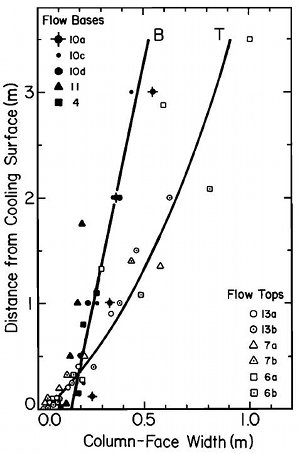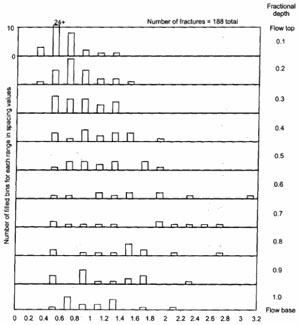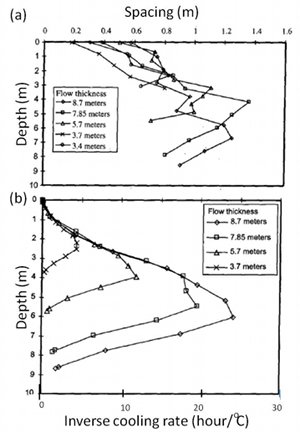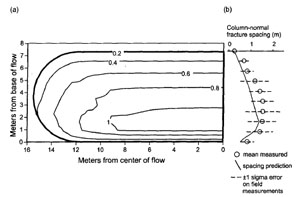| |||||||
|
|
|||||||
|
|
|||||||
| Columnar Joint Spacing | |||||||
|
In contrast to spacing of tectonic joints in layered sedimentary rocks, spacing of most columnar joints is not so straight forward to characterize because columnar joints commonly have polygonal cross sections often with non-parallel sides which make it difficult to consistently define a joint spacing. However, column diameter or column face width can be used as proxy for joint spacing, which is easy to measure. Even this method may provide complex spacing distributions from one plane to another perpendicular to the axes of columns and from the cooling surfaces toward the interior of a cooling body. For example, Figure 1 shows spacing data of columnar joints measured from basaltic lava flows in 13 sites in the western United States (Ryan and Sammis, 1978; DeGraff and Aydin, 1993). The approximate best fit curves correspond to data measured from the top (T) and the base (B) of the flows. The data from each site show a systematic increase of joint spacing with distance from the cooling surface. The rate of increase of joint spacing going down from the flow tops is about two to three times larger than that going up from the flow bases, while the initial joint spacing at the flow tops is about three times smaller than that at the flow bases. Interestingly, joint growth increments also show a comparable systematic variation as shown in Figure 2 from the same authors.
Figure 3 shows these variations displayed by a histogram constructed using data from a single basaltic lava flow exposed at Box Canyon in the eastern Snake River Plain, Idaho (Lore et al., 2001). Figure 4 includes joint spacing versus depth plots for five basalt flows from the same locality (including the data in Figure 3), but plotted in a different way. These plots show increasing fracture spacing with distance from the top and the base of the flows for two fracture systems in each flow, which propagated inward from the top surface and the base, respectively. Another important trend of the data sets in Figure 4 is that there is a systematic overall increase in fracture spacing with larger flow thickness. It has been known for a long time that this is controlled by thickness of lava flows, more precisely their temperature regimes and related thermal stresses. Columnar joint spacing commonly increases with increasing distance inwards from the cooling boundaries as a function of cooling rate. The maximum spacing commonly occurs around one third to the bottom of the lava layer. The variation with depth of inverse cooling rate calculated at 900 degrees C for each case in the same data sets as in Figure 4 using idealized sheet-like lava flow geometry and the measured maximum thicknesses is given in Figure 5 (Lore et al., 2001). This variation of inverse cooling rate is quite consistent in the upper portion of each flow, but it deviates somewhat in the lower portion presumably due to the effect of substrate which may include ground surface with normal background temperature and previous lava flows from earlier eruptions with above normal ground temperature. In any case, spacing of thermal joints appear to have a power relationship to the inverse of cooling rate; larger spacing is associated with slower cooling rates from the flow bases and smaller spacing for faster cooling rates from the lava surfaces with the greatest spacing below the center of lava flows. These conclusions are consistent with definitions of colonnade and entablature, respectively, in lava layers defined earlier in the 'Growth of Columnar Joints.' If the cooling rates from the top and the bottom were the same, the greatest thermal joint spacing would have occurred at the center. For example, spherical or cylindrical volcanic bombs (lapilli) show this kind of symmetric distribution. For most lava flows, however, the maximum spacing commonly occurs around one third to the bottom of the lava layer. Also important to point out is a factor related to the convective cooling by water from the top surface, which results in local heterogeneities in the orientation and spacing of columnar joints in the upper portions of lava flows (DeGraff and Aydin, 1987). These issues will be discussed further in the sections on growth of thermal contraction joints and their mechanisms and mechanics. | |||||||
| Reference: |
|||||||
| DeGraff, J.M., Aydin, A., 1987 DeGraff, J.M., Aydin, A., 1993 Lore, J., Aydin, A., Goodson, K., 2001 Ryan, M.P., Sammis, C.G., 1981 |
|||||||
|
Readme | About Us | Acknowledgement | How to Cite | Terms of Use | Ⓒ Rock Fracture Knowledgebase |
|||||||




